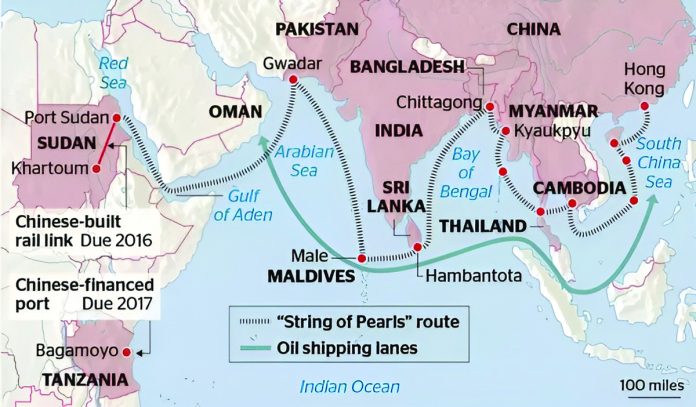Dr. S. Bushra Batool
The term “String of Pearls” refers to China’s strategic initiative to establish a network of military and commercial facilities across the Indian Ocean Region (IOR), effectively creating a geopolitical arc that encircles India. Each “pearl” symbolizes a port or base where China has invested heavily, forming a chain stretching from the Chinese mainland to Port Sudan in Africa.
These facilities, while often developed under the banner of commercial expansion and infrastructure development, raise significant security concerns due to their potential to be repurposed for military use during times of conflict. This strategy represents a broader shift in China’s maritime posture from a historically Pacific Ocean-focused presence to a newfound emphasis on the Indian Ocean. China’s goals include safeguarding energy routes, expanding maritime trade influence, and projecting power in a region historically dominated by India and Western naval forces.
Key nodes in the string of pearls
- a) Gwadar Port, Pakistan
Located near the Strait of Hormuz, Gwadar offers China a critical gateway to the Persian Gulf, through which nearly 20% of the world’s oil transits. The port is central to the China Pakistan Economic Corridor (CPEC) and holds the potential to serve not just as a trade hub, but also as a surveillance outpost or even a military facility. Gwadar enhances China’s energy security by offering a shorter overland route to western China while simultaneously undermining Indian and U.S. dominance in the Arabian Sea.
- b) Hambantota Port, Sri Lanka
Strategically placed on Sri Lanka’s southern coast, Hambantota sits near vital east west shipping lanes. Though officially leased for 99 years to a Chinese company for commercial purposes, concerns persist that it could become a PLA Navy logistics hub. Hambantota is a major node in China’s Belt and Road Initiative (BRI), and its proximity to India’s southern coast makes it especially sensitive.
- c) Chittagong Port, Bangladesh
The Chittagong (Chattogram) port enhances China’s maritime reach in South Asia and is positioned near the Strait of Malacca, a critical trade artery. China has significantly invested in the port and surrounding infrastructure, including the Karnaphuli tunnel, industrial zones, and power projects. Through these projects, China gains long-term economic influence in Bangladesh and a potential monitoring post near eastern India and the Andaman & Nicobar Islands.
- d) Sittwe Port, Myanmar
Sittwe, located on Myanmar’s western coast, serves as a pivotal link in China’s strategy to bypass the Malacca Strait a known choke point for energy shipments. With overland infrastructure like pipelines and highways to Yunnan province in southern China, Sittwe allows China to import oil from the Middle East without traversing vulnerable sea routes. This port also enhances China’s footprint in the Bay of Bengal, putting it closer to Indian naval assets.
- e) Hainan Island, China
While not foreign territory, Hainan Island in the South China Sea is China’s primary naval launchpad into the Indian Ocean. Home to the Yulin Naval Base the country’s largest and most advanced Hainan hosts nuclear submarines, aircraft carriers, and other assets from the PLA Navy’s South Sea Fleet. It forms the operational hub from which China can sustain long-range deployments and connect with other pearls across the Indian Ocean.
Strategic Implications for India
India views the String of Pearls as a direct challenge to its strategic autonomy, especially in its immediate maritime neighborhood. This initiative, when combined with the China Pakistan Economic Corridor and the broader Belt and Road Initiative, signals Beijing’s intention to establish a semi-permanent presence in the IOR, potentially limiting India’s regional influence.
Key concerns for India:
- Strategic Encirclement: The growing network of Chinese bases around India threatens to dilute India’s dominance in the Indian Ocean. Although China lacks direct coastal access to the IOR, its ability to operate from friendly ports allows it to project power deep into India’s maritime backyard.
- Economic Diversion: Rising security threats may force India to divert more resources toward defense spending, potentially hampering economic growth and development in other sectors.
- Maritime Security Risks: China’s naval expansion, including its growing fleet of submarines and destroyers, poses a threat to Indian maritime interests and could compromise sea lanes critical for trade and energy supplies.
- Pakistan Factor: China’s military and economic backing of Pakistan, especially in Gwadar, fuels long-standing concerns of a two-front challenge for India on both land and sea.
- Eastern Flank Vulnerability: Ports like Kyaukpyu in Myanmar and the infrastructure at Sittwe are also viewed with alarm, as they place Chinese influence close to India’s eastern seaboard.
India’s countermeasures
In response to China’s expanding influence, India has adopted a multi-pronged approach, involving diplomatic engagement, defense partnerships, infrastructure development, and strategic naval deployments.
- a) Strategic expansion in the Gulf of Oman
India has been steadily increasing its naval presence in the Gulf of Oman a critical gateway to the Strait of Hormuz and Persian Gulf oil routes. Notable initiatives include:
- Operation Sankalp (2019 present): Launched to escort Indian merchant vessels after rising U.S.-Iran tensions.
- Mission-based deployments: The Indian Navy now regularly rotates warships through the region to ensure a constant strategic presence.
- b) Strengthening Port Access and Alliances
India has deepened partnerships with countries like Oman and Iran:
- Duqm Port (Oman): India has secured access for refueling and resupply of naval vessels. Oman also allows joint training and hosts Indian military personnel.
- Chabahar Port (Iran): In May 2024, India signed a 10-year deal to operate the Shahid Beheshti terminal. With an investment of $120 million, this gives India overland access to Afghanistan and Central Asia, bypassing Pakistan-controlled routes and countering Chinese control at Gwadar.
- c) Naval Exercises and Regional Engagement
India actively conducts joint naval exercises such as:
- Naseem Al Bahr with Oman, enhancing interoperability.
- Bilateral and trilateral engagements with UAE, Iran, and other Gulf nations to bolster maritime diplomacy.
Conclusion
The String of Pearls is more than just a maritime infrastructure strategy it’s a blueprint for geostrategic dominance. While China insists that these developments are purely commercial, the dual-use nature of ports and bases leaves room for strategic repurposing, particularly in the event of conflict.
For India, the challenge is multifaceted; it must protect its maritime interests, sustain its influence across the IOR, and forge robust partnerships to counterbalance China’s ambitions. With calculated diplomacy, strategic port agreements, and a forward-leaning naval policy, India is gradually building its own network, a “Necklace of Diamonds,” to safeguard its future in the Indian Ocean.
The author is a Research Officer at Rabita Forum International (RFI).







